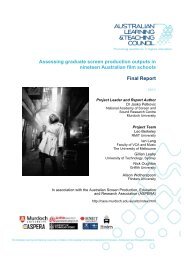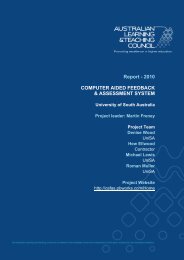Download Document - Office for Learning and Teaching
Download Document - Office for Learning and Teaching
Download Document - Office for Learning and Teaching
You also want an ePaper? Increase the reach of your titles
YUMPU automatically turns print PDFs into web optimized ePapers that Google loves.
The identification in<strong>for</strong>mation section includes the educational degree ofrespondents; study field of respondents; how long the respondents have studied inAustralia; birth country of respondents; first language of respondents; <strong>and</strong> whichcountry respondents were mainly educated in. This in<strong>for</strong>mation helps to identify therespondents’ major <strong>and</strong> the cultural background the respondent belongs to.In this study, ‘international student’ is identified as the student who has completedmost of the education in countries other than Australia. This definition is the mostsuitable <strong>for</strong> the Australian immigration situation. From the data obtained in thisproject, over 90% of international students are Asian students. There<strong>for</strong>e,“international students” in this report means international students of Asianbackground.Below we will discuss the approach we used to design questions under the five mainaspects identified above:(1) In the teaching content <strong>and</strong> textbooks aspect of the questionnaire, we assumedthat textbooks have different degrees of importance <strong>and</strong> are used in different waysin different cultural backgrounds. In some countries, teachers use textbooks a lot intheir subjects <strong>and</strong> students mainly follow textbooks <strong>for</strong> their study. However, in othercountries, teachers do not use textbooks or use only very limited selected parts oftextbooks in their subjects. They prefer to design their personal lecture notes <strong>and</strong>just give students slides in the classroom <strong>and</strong> references <strong>for</strong> reading. There<strong>for</strong>e,students from different countries have different attitudes <strong>and</strong> behaviours towards theuse of textbooks. This part of the survey aims to obtain feedback about students’attitudes to teaching content <strong>and</strong> textbooks. Some examples of questions include:how students evaluate textbooks; the difficulties they have when they readtextbooks; what content students read in textbooks; <strong>and</strong> if they use textbooks writtenin another language.(2) <strong>Teaching</strong> <strong>and</strong> learning method is one of the most important issues involved inthe questionnaire. It is assumed that international students <strong>and</strong> local studentsexperience different teaching methods prior to current university study <strong>and</strong> theirlearning methods may be also different. This part of the survey is intended to testthis assumption. Questions include: whether students feel that the current teachingmethods are suitable; what the main differences are between the teaching methodsin Australia <strong>and</strong> their home country; whether they like lecturers to ask questions inclasses; what aspects of teaching concern them most; <strong>and</strong> how satisfied studentsare with the teaching methods in their current subjects.(3) International students may have a different education management system intheir home country which is adapted to the local cultural background. There<strong>for</strong>e, theeducation management system part of the questionnaire aims to acquire feedbackfrom international students on how they adapt to the Australian educationmanagement system. Questions include: experience with the academic creditsystem; attitude to elective subjects; evaluating guidance within the educationmanagement system; <strong>and</strong> evaluating the degree of satisfaction with the subjectselection system.(4) Language difference is the first problem that will be met by internationalstudents. It is the main obstacle preventing international students from improvingtheir per<strong>for</strong>mance in the overseas study process. Questions on language include:whether the main reason <strong>for</strong> communication difficulty is the language; dointernational students have difficulties in underst<strong>and</strong>ing lectures due to the languageproblem; do international students have language-related difficulties in completinghomework/assignments; do international students have the confidence to take partin asking questions <strong>and</strong> in-class discussions; <strong>and</strong> do international studentsexperience difficulty when they per<strong>for</strong>m oral presentations in class.9
















